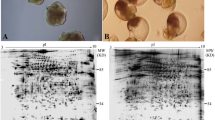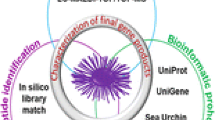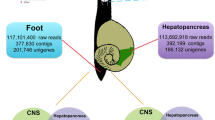Abstract
Aplysia proteins have not been studied systematically and it was therefore the aim of the study to carry out protein profiling in ganglia from Aplysia californica (AC). AC ganglia were extirpated, proteins extracted and run on 2DE with subsequent in-gel digestion, followed by identification of proteins by nano-LC–ESI–MS/MS on an ion trap. Proteins were identified based upon a public Aplysia EST database. Out of 408 picked spots, 276 spots were identified corresponding to 172 ESTs and 118 individual proteins. The range of sequence coverage was between 14 and 80% and the average amount of peptides used for the identification of proteins was 9 (from 3 to 24). Mean score for protein identification was 516. Comparison of protein levels between cerebral, pleural, pedal and abdominal ganglia revealed a series of significant differences including: signaling, metabolism, cytoskeleton and structural, redox, chaperone, replication/transcription and electron/proton transport proteins. The generation of a protein map complements transcriptional studies carried out in AC ganglia. The findings provide the basis for investigation into post-translational modifications, splice variants and assist in the generation of antibodies against AC proteins. Moreover, differences in protein expression between ganglia may be valuable for the design of future studies in neurobiology of AC.




Similar content being viewed by others
References
Afjehi-Sadat L, Lubec G (2007) Identification of enzymes and activity from two-dimensional gel electrophoresis. Nat Protoc 2:2318–2324
Ambron RT, Den H, Schacher S (1985) Synaptogenesis by single identified neurons in vitro: contribution of rapidly transported and newly synthesized proteins. J Neurosci 5:2857–2865
Angers A, Storozhuk MV, Duchaine T et al (1998) Cloning and functional expression of an Aplysia 5-HT receptor negatively coupled to adenylate cyclase. J Neurosci 18:5586–5593
Barbas D, Zappulla JP, Angers S et al (2002) Functional characterization of a novel serotonin receptor (5-HTap2) expressed in the CNS of Aplysia californica. J Neurochem 80:335–345
Barbas D, Campbell A, Castellucci VF, DesGroseillers L (2005) Comparative localization of two serotonin receptors and sensorin in the central nervous system of Aplysia californica. J Comp Neurol 490:295–304
Bergold PJ, Sweatt JD, Winicov I et al (1990) Protein synthesis during acquisition of long-term facilitation is needed for the persistent loss of regulatory subunits of the Aplysia cAMP-dependent protein kinase. Proc Natl Acad Sci USA 87:3788–3791
Bergold PJ, Beushausen SA, Sacktor TC et al (1992) A regulatory subunit of the cAMP-dependent protein kinase down-regulated in aplysia sensory neurons during long-term sensitization. Neuron 8:387–397
Bougie JK, Lim T, Farah CA et al (2009) The atypical protein kinase C in Aplysia can form a protein kinase M by cleavage. J Neurochem 109:1129–1143
Brejc K, van Dijk WJ, Klaassen RV et al (2001) Crystal structure of an ACh-binding protein reveals the ligand-binding domain of nicotinic receptors. Nature 411:269–276
Carroll M, Warren O, Fan X, Sossin WS (2004) 5-HT stimulates eEF2 dephosphorylation in a rapamycin-sensitive manner in Aplysia neurites. J Neurochem 90:1464–1476
Casadio A, Martin KC, Giustetto M et al (1999) A transient, neuron-wide form of CREB-mediated long-term facilitation can be stabilized at specific synapses by local protein synthesis. Cell 99:221–237
Chen A, Muzzio IA, Malleret G et al (2003) Inducible enhancement of memory storage and synaptic plasticity in transgenic mice expressing an inhibitor of ATF4 (CREB-2) and C/EBP proteins. Neuron 39:655–669
Chen WQ, Kang SU, Lubec G (2006) Protein profiling by the combination of two independent mass spectrometry techniques. Nat Protoc 1:1446–1452
Chen WQ, Salmazo A, Myllykoski M et al (2010) Purification of recombinant growth hormone by clear native gels for conformational analyses: preservation of conformation and receptor binding. Amino Acids 39:859–869
Cibelli G, Ghirardi M, Onofri F et al (1996) Synapsin-like molecules in Aplysia punctata and Helix pomatia: identification and distribution in the nervous system and during the formation of synaptic contacts in vitro. Eur J Neurosci 8:2530–2543
Collado MS, Khabour O, Fioravante D et al (2009) Post-translational regulation of an Aplysia glutamate transporter during long-term facilitation. J Neurochem 108:176–189
Dash PK, Moore AN (1996) Characterization and phosphorylation of CREB-like proteins in Aplysia central nervous system. Brain Res Mol Brain Res 39:43–51
Dyer JR, Sossin WS, Klein M (1996) Cloning and characterization of aplycalcin and Aplysia neurocalcin, two new members of the calmodulin superfamily of small calcium-binding proteins. J Neurochem 67:932–942
Ezzeddine Y, Glanzman DL (2003) Prolonged habituation of the gill-withdrawal reflex in Aplysia depends on protein synthesis, protein phosphatase activity, and postsynaptic glutamate receptors. J Neurosci 23:9585–9594
Fan X, Qian Y, Fricker LD et al (1999) Cloning and expression of Aplysia carboxypeptidase D, a candidate prohormone-processing enzyme. DNA Cell Biol 18:121–132
Farah CA, Weatherill D, Dunn TW, Sossin WS (2009) PKC differentially translocates during spaced and massed training in Aplysia. J Neurosci 29:10281–10286
Fioravante D, Liu RY, Byrne JH (2008) The ubiquitin-proteasome system is necessary for long-term synaptic depression in Aplysia. J Neurosci 28:10245–10256
Fountoulakis M, Schuller E, Hardmeier R et al (1999) Rat brain proteins: two-dimensional protein database and variations in the expression level. Electrophoresis 20:3572–3579
Fountoulakis M, Juranville JF, Dierssen M, Lubec G (2002) Proteomic analysis of the fetal brain. Proteomics 2:1547–1576
Furukawa Y, Miyawaki Y, Abe G (2006) Molecular cloning and functional characterization of the Aplysia FMRFamide-gated Na+ channel. Pflugers Arch 451:646–656
Garbe JC, Yang E, Fristrom JW (1993) IMP-L2: an essential secreted immunoglobulin family member implicated in neural and ectodermal development in Drosophila. Development 119:1237–1250
Greenberg SM, Castellucci VF, Bayley H, Schwartz JH (1987) A molecular mechanism for long-term sensitization in Aplysia. Nature 329:62–65
Guan X, Clark GA (2006) Essential role of somatic and synaptic protein synthesis and axonal transport in long-term synapse-specific facilitation at distal sensorimotor connections in Aplysia. Biol Bull 210:238–254
Han JH, Lim CS, Lee YS et al (2004) Role of Aplysia cell adhesion molecules during 5-HT-induced long-term functional and structural changes. Learn Mem 11:421–435
Han JH, Lee C, Cheang Y, Kaang BK (2005) Suppression of long-term facilitation by Rab3-effector protein interaction. Brain Res Mol Brain Res 139:13–22
Hansen SB, Talley TT, Radic Z, Taylor P (2004) Structural and ligand recognition characteristics of an acetylcholine-binding protein from Aplysia californica. J Biol Chem 279:24197–24202
Hernandez AI, Wolk J, Hu JY et al (2009) Poly-(ADP-ribose) polymerase-1 is necessary for long-term facilitation in Aplysia. J Neurosci 29:9553–9562
Hislop J, Dyer JR, Scott D et al (2004) Characterization of a novel molluskan tyrosine kinase receptor that inhibits neurite regeneration. J Neurobiol 60:127–136
Houeland G, Nakhost A, Sossin WS, Castellucci VF (2007) PKC modulation of transmitter release by SNAP-25 at sensory-to-motor synapses in aplysia. J Neurophysiol 97:134–143
Jang DH, Han JH, Lee SH et al (2005) Cofilin expression induces cofilin-actin rod formation and disrupts synaptic structure and function in Aplysia synapses. Proc Natl Acad Sci USA 102:16072–16077
Jezzini SH, Moroz LL (2004) Identification and distribution of a two-pore domain potassium channel in the CNS of Aplysia californica. Brain Res Mol Brain Res 127:27–38
Jezzini SH, Reagin S, Kohn AB, Moroz LL (2006) Molecular characterization and expression of a two-pore domain potassium channel in the CNS of Aplysia californica. Brain Res 1094:47–56
Juvvadi S, Fan X, Nagle GT, Fricker LD (1997) Characterization of Aplysia carboxypeptidase E. FEBS Lett 408:195–200
Kang SU, Fuchs K, Sieghart W et al (2009) Gel-based mass spectrometric analysis of a strongly hydrophobic GABAA-receptor subunit containing four transmembrane domains. Nat Protoc 4:1093–1102
Kennedy TE, Kuhl D, Barzilai A et al (1992) Long-term sensitization training in Aplysia leads to an increase in calreticulin, a major presynaptic calcium-binding protein. Neuron 9:1013–1024
Kim H, Lee SH, Han JH et al (2006) A nucleolar protein ApLLP induces ApC/EBP expression required for long-term synaptic facilitation in aplysia neurons. Neuron 49:707–718
Krapfenbauer K, Fountoulakis M, Lubec G (2003) A rat brain protein expression map including cytosolic and enriched mitochondrial and microsomal fractions. Electrophoresis 24:1847–1870
Kress TL, Yoon YJ, Mowry KL (2004) Nuclear RNP complex assembly initiates cytoplasmic RNA localization. J Cell Biol 165:203–211
Kruse R, Sweedler JV (2003) Spatial profiling invertebrate ganglia using MALDI MS. J Am Soc Mass Spectrom 14:752–759
Kuhl D, Kennedy TE, Barzilai A, Kandel ER (1992) Long-term sensitization training in Aplysia leads to an increase in the expression of BiP, the major protein chaperon of the ER. J Cell Biol 119:1069–1076
Langen H, Berndt P, Roder D et al (1999) Two-dimensional map of human brain proteins. Electrophoresis 20:907–916
Lee JA, Lee SH, Lee C et al (2006) PKA-activated ApAF-ApC/EBP heterodimer is a key downstream effector of ApCREB and is necessary and sufficient for the consolidation of long-term facilitation. J Cell Biol 174:827–838
Liu J, Hu JY, Schacher S, Schwartz JH (2004) The two regulatory subunits of aplysia cAMP-dependent protein kinase mediate distinct functions in producing synaptic plasticity. J Neurosci 24:2465–2474
Lubec G, Afjehi-Sadat L (2007) Limitations and pitfalls in protein identification by mass spectrometry. Chem Rev 107:3568–3584
Martin KC, Hu Y, Armitage BA et al (1995) Evidence for synaptotagmin as an inhibitory clamp on synaptic vesicle release in Aplysia neurons. Proc Natl Acad Sci USA 92:11307–11311
Martin KC, Casadio A, Zhu H et al (1997a) Synapse-specific, long-term facilitation of aplysia sensory to motor synapses: a function for local protein synthesis in memory storage. Cell 91:927–938
Martin KC, Michael D, Rose JC et al (1997b) MAP kinase translocates into the nucleus of the presynaptic cell and is required for long-term facilitation in Aplysia. Neuron 18:899–912
Moccia R, Chen D, Lyles V et al (2003) An unbiased cDNA library prepared from isolated Aplysia sensory neuron processes is enriched for cytoskeletal and translational mRNAs. J Neurosci 23:9409–9417
Moroz LL, Edwards JR, Puthanveettil SV et al (2006) Neuronal transcriptome of aplysia: neuronal compartments and circuitry. Cell 127:1453–1467
Myung JK, Lubec G (2006) Use of solution-IEF-fractionation leads to separation of 2673 mouse brain proteins including 255 hydrophobic structures. J Proteome Res 5:1267–1275
Park H, Lee JA, Lee C et al (2005) An Aplysia type 4 phosphodiesterase homolog localizes at the presynaptic terminals of Aplysia neuron and regulates synaptic facilitation. J Neurosci 25:9037–9045
Purcell AL, Sharma SK, Bagnall MW et al (2003) Activation of a tyrosine kinase-MAPK cascade enhances the induction of long-term synaptic facilitation and long-term memory in Aplysia. Neuron 37:473–484
Reissner KJ, Boyle HD, Ye X, Carew TJ (2008) Aplysia synapse associated protein (APSAP): identification, characterization, and selective interactions with Shaker-type potassium channels. J Neurochem 105:1006–1018
Schacher S, Castellucci VF, Kandel ER (1988) cAMP evokes long-term facilitation in Aplysia sensory neurons that requires new protein synthesis. Science 240:1667–1669
Sharma SK, Sherff CM, Shobe J et al (2003) Differential role of mitogen-activated protein kinase in three distinct phases of memory for sensitization in Aplysia. J Neurosci 23:3899–3907
Si K, Giustetto M, Etkin A et al (2003) A neuronal isoform of CPEB regulates local protein synthesis and stabilizes synapse-specific long-term facilitation in aplysia. Cell 115:893–904
Skehel PA, Armitage BA, Bartsch D et al (1995) Proteins functioning in synaptic transmission at the sensory to motor synapse of Aplysia. Neuropharmacology 34:1379–1385
Smit AB, Syed NI, Schaap D et al (2001) A glia-derived acetylcholine-binding protein that modulates synaptic transmission. Nature 411:261–268
Strumwasser F, Wilson DL (1976) Patterns of proteins synthesized in the R15 neuron of Aplysia. Temporal studies and evidence for processing. J Gen Physiol 67:691–702
Sung YJ, Walters ET, Ambron RT (2004) A neuronal isoform of protein kinase G couples mitogen-activated protein kinase nuclear import to axotomy-induced long-term hyperexcitability in Aplysia sensory neurons. J Neurosci 24:7583–7595
Swanson ME, Elste AM, Greenberg SM et al (1986) Abundant expression of ras proteins in Aplysia neurons. J Cell Biol 103:485–492
Whim MD, Kaczmarek LK (1998) Expression of a foreign G-protein coupled receptor modulates the excitability of the peptidergic bag cell neurons of Aplysia. Neurosci Lett 258:143–146
Wickham L, Zappulla JP, DesGroseillers L (1999) Molecular cloning, sequence analysis and expression distribution of an aminopeptidase in Aplysia california. Comp Biochem Physiol B Biochem Mol Biol 124:429–437
Wilson DL (1971) Molecular weight distribution of proteins synthesized in single, identified neurons of Aplysia. J Gen Physiol 57:26–40
Wood V, Gwilliam R, Rajandream MA et al (2002) The genome sequence of Schizosaccharomyces pombe. Nature 415:871–880
Yang JW, Czech T, Lubec G (2004) Proteomic profiling of human hippocampus. Electrophoresis 25:1169–1174
Yang H, Johnson PM, Ko KC et al (2005a) Cloning, characterization and expression of escapin, a broadly antimicrobial FAD-containing L-amino acid oxidase from ink of the sea hare Aplysia californica. J Exp Biol 208:3609–3622
Yang JW, Rodrigo R, Felipo V, Lubec G (2005b) Proteome analysis of primary neurons and astrocytes from rat cerebellum. J Proteome Res 4:768–788
Yang JW, Afjehi-Sadat L, Gelpi E et al (2006) Proteome profiling in the rat Harderian gland. J Proteome Res 5:1751–1762
Yanow SK, Manseau F, Hislop J et al (1998) Biochemical pathways by which serotonin regulates translation in the nervous system of Aplysia. J Neurochem 70:572–583
Zappulla JP, Angers A, Barbas D et al (2005) A novel actin isoform is expressed in the ovotestis of Aplysia californica. Comp Biochem Physiol B Biochem Mol Biol 140:403–409
Zarkadis I, Vezyri E, Kouvelas E et al (1997) cDNA cloning of the translocon associated protein beta-subunit in the chick cerebellum. Gene 201:1–4
Zhao Y, Wang DO, Martin KC (2009) Preparation of Aplysia sensory-motor neuronal cell cultures. J Vis Exp 28:pii:1355. doi:10.3791/1355
Zheng JF, Patil SS, Chen WQ et al (2009) Hippocampal protein levels related to spatial memory are different in the Barnes maze and in the multiple T-maze. J Proteome Res 8:4479–4486
Acknowledgment
We thank Isabella Divisch for her help on quantification.
Conflict of interest
The authors herewith declare that there is no financial/commercial conflict of interest.
Author information
Authors and Affiliations
Corresponding author
Additional information
Y. Sun and F. J. Monje have equally contributed to the work.
Electronic supplementary material
Below is the link to the electronic supplementary material.
Rights and permissions
About this article
Cite this article
Sun, Y., Monje, F.J., Pollak, D.D. et al. A first partial Aplysia californica proteome. Amino Acids 41, 955–968 (2011). https://doi.org/10.1007/s00726-010-0795-9
Received:
Accepted:
Published:
Issue Date:
DOI: https://doi.org/10.1007/s00726-010-0795-9




